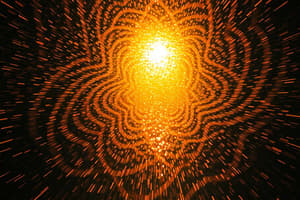Podcast
Questions and Answers
What is the main phenomenon described in the text?
What is the main phenomenon described in the text?
- The bending of waves as they encounter barriers
- The behavior of light when passing through narrow slits (correct)
- The splitting of waves into interference patterns
- The interaction of waves with particles
What is the key factor that determines the degree of diffraction?
What is the key factor that determines the degree of diffraction?
- The material of the obstacle
- The angle of incidence of the wave
- The speed of the wave
- The size of the gap relative to the wavelength of the wave (correct)
What principle provides a theoretical framework to describe the diffraction phenomenon?
What principle provides a theoretical framework to describe the diffraction phenomenon?
- The Interference principle
- The Huygens-Fresnel principle (correct)
- The Maxwell's equations
- The Superposition principle
What is a consequence of the wave nature of light?
What is a consequence of the wave nature of light?
What is the main application of diffraction mentioned in the text?
What is the main application of diffraction mentioned in the text?
What is the primary cause of bright regions in a diffraction pattern?
What is the primary cause of bright regions in a diffraction pattern?
Which imaging technique utilizes diffraction to determine the three-dimensional structures of molecules?
Which imaging technique utilizes diffraction to determine the three-dimensional structures of molecules?
What is the effect of increasing the size of the slit in a diffraction experiment?
What is the effect of increasing the size of the slit in a diffraction experiment?
Which field of study relies on the diffraction of light to separate different wavelengths for material analysis?
Which field of study relies on the diffraction of light to separate different wavelengths for material analysis?
What phenomenon occurs when the troughs of waves align, causing the amplitudes to cancel out?
What phenomenon occurs when the troughs of waves align, causing the amplitudes to cancel out?
Flashcards are hidden until you start studying
Study Notes
Introduction
Diffraction refers to the phenomena of waves interacting with particles, particularly how light behaves when passing through narrow slits or around obstacles. It involves the bending or splitting of waves as they encounter barriers, leading to the formation of intricate interference patterns. This property is a direct consequence of the wave nature of light. In this article, we will explore various aspects of diffraction, focusing on its principles, key concepts, and applications.
Principles of Diffraction
Diffraction arises when light waves encounter an obstacle, such as a narrow slit or a corner. The diffracting object or aperture essentially acts as a secondary source, causing the light waves to bend or scatter. The degree of diffraction depends on the size of the gap relative to the wavelength of the wave. When the gap is similar to the wavelength, the diffraction is most pronounced, resulting in the formation of semi-circular waves.
Huygens-Fresnel Principle
The Huygens-Fresnel principle provides a theoretical framework to describe the diffraction phenomenon. According to this principle, each point in a propagating wavefront can be treated as a secondary source, with light waves emanating from each point in multiple directions. These secondary waves overlap to form the observed interference pattern.
Applications of Diffraction
Diffraction has numerous applications in various scientific domains, ranging from fundamental research to practical applications. Some notable examples include:
- Optical Microscopy: Diffraction plays a crucial role in the functioning of microscopes, allowing researchers to magnify and visualize structures too small to be seen with the naked eye.
- Spectroscopy: The study of spectroscopy relies on the diffraction of light to separate different wavelengths, enabling the identification and analysis of chemical compositions of materials.
- Telecommunications: In telecommunications, the diffraction of radio waves around buildings and other obstacles is essential for the coverage and propagation of wireless signals.
- Imaging Techniques: Diffraction techniques are used in various imaging modalities like X-ray crystallography to determine the three-dimensional structures of molecules and biomolecules.
Key Concepts
Constructive Interference
Constructive interference occurs when crests of two or more waves align, effectively enhancing the amplitude and increasing the intensity of light. This results in bright regions in the diffraction pattern.
Destructive Interference
Destructive interference occurs when troughs of two waves align, causing the amplitudes to cancel out. The resulting wave has reduced amplitude, leading to darker regions in the diffraction pattern.
Wavelength and Slit Size
The wavelength and size of slits play a significant role in influencing the intensity patterns seen in diffraction experiments. Smaller slits generally lead to larger diffraction angles, while larger slits result in smaller angles. Additionally, when the width of a slit is comparable to the wavelength of light passing through it, the diffraction pattern tends to exhibit well-defined maxima and minima.
In conclusion, diffraction is an intriguing aspect of wave behavior that governs how light interacts with physical barriers. Its principles have far-reaching implications across diverse scientific disciplines and technological applications. As we continue to explore this fascinating phenomenon, our understanding of the underlying physics and its potential uses will only grow in depth and breadth.
Studying That Suits You
Use AI to generate personalized quizzes and flashcards to suit your learning preferences.





